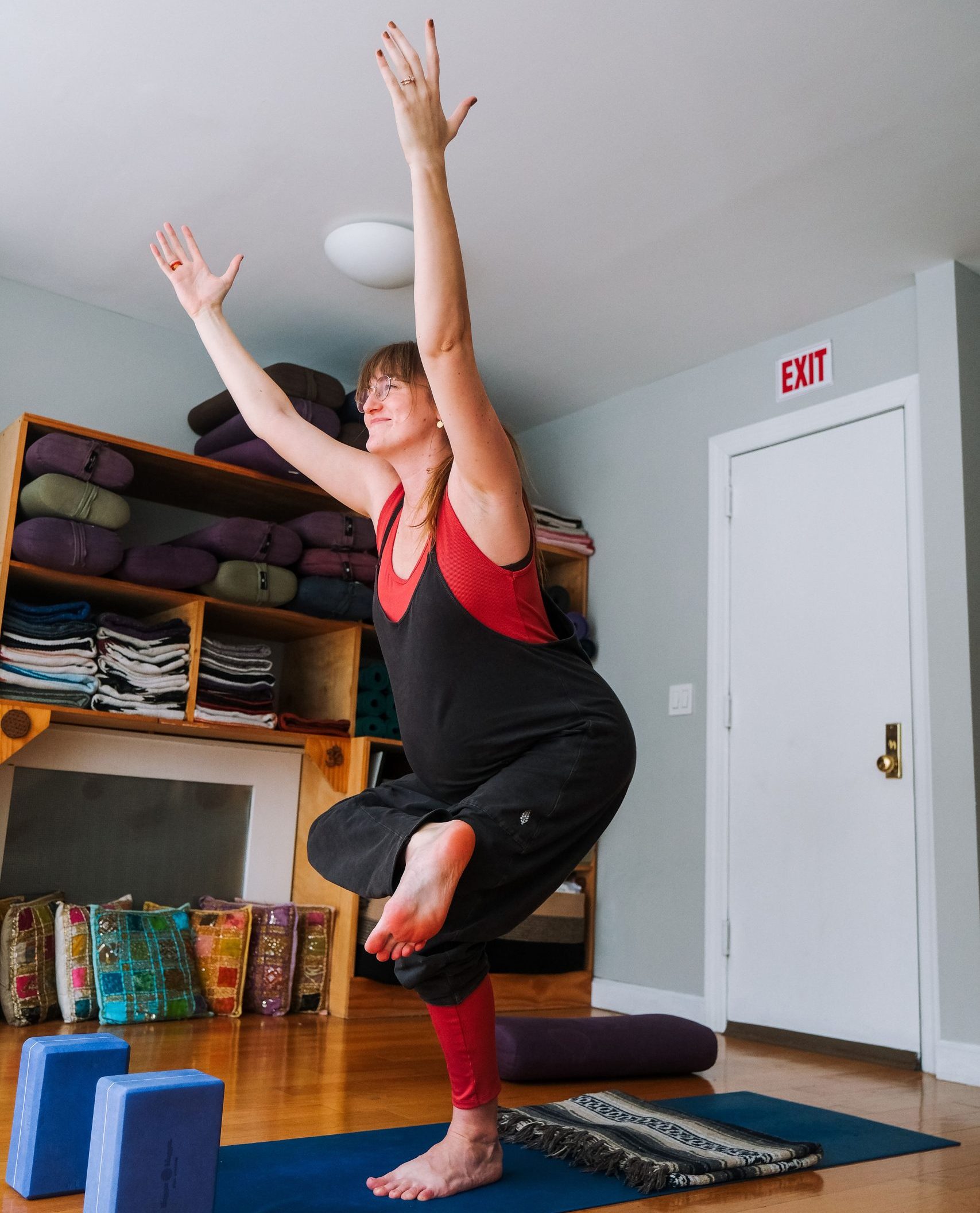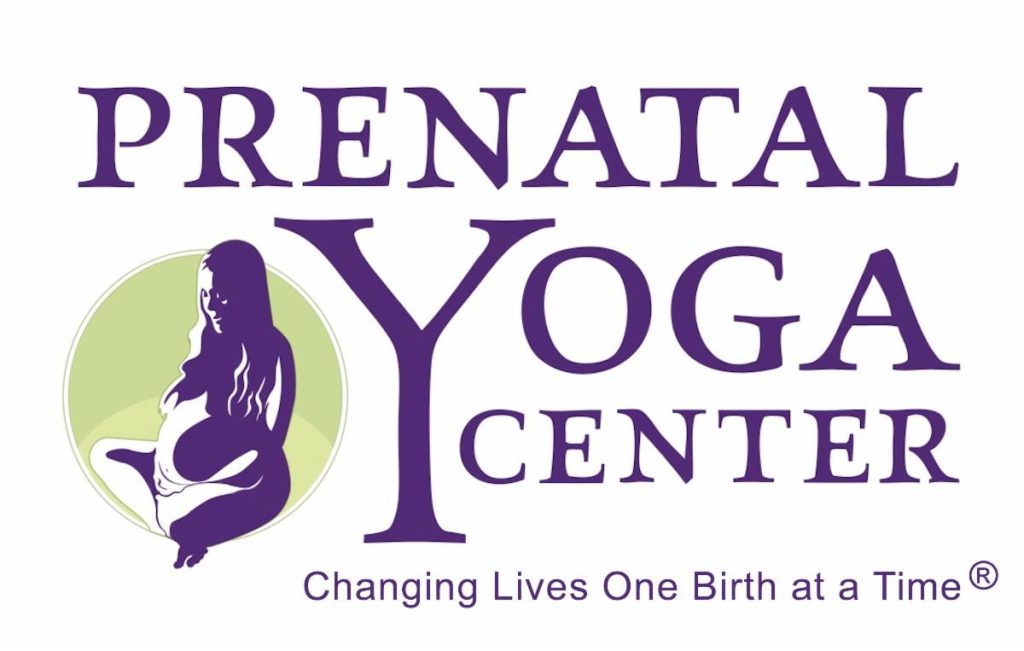Navigation
- Romanian Deadlift (RDL)/ Hip Hinge
- Donkey Kicks
- Bridge with Block
- Reverse Clamshell
- Scapula Push-Ups
- Opposite Limb Extension (Bird Dog)
- Half Chaturanga with Transverse Abdominal (TA)Breathing
- Final Thoughts: Confidence and Communication
- Related Reading and Listening!
Prenatal yoga is often mistaken for just gentle stretching and restorative poses. While relaxation certainly plays a role, at Prenatal Yoga Center (PYC) we approach prenatal yoga with a much broader purpose. Our classes are designed to offer physical challenge, help build strength, and develop the coping skills needed to manage discomfort and strong sensations—valuable tools both during pregnancy and labor.
Another essential goal of our classes is to help bring the body into balance. Pregnancy creates major postural shifts that often lead to muscular imbalances. Many students develop an anterior pelvic tilt with flared ribs, or the opposite pattern with the hips pushed forward and the tailbone tucked under. These patterns can lead to back and shoulder pain, pelvic floor dysfunction and headaches. To counteract these tendencies, we focus on strengthening the posterior chain—glutes, hamstrings, back, and deep core.
In every PYC prenatal yoga class, we weave strengthening poses throughout the vinyasa flow. Let’s take a look at some of our favorite functional strength moves and how they support pregnant bodies.
Romanian Deadlift (RDL) / Hip Hinge
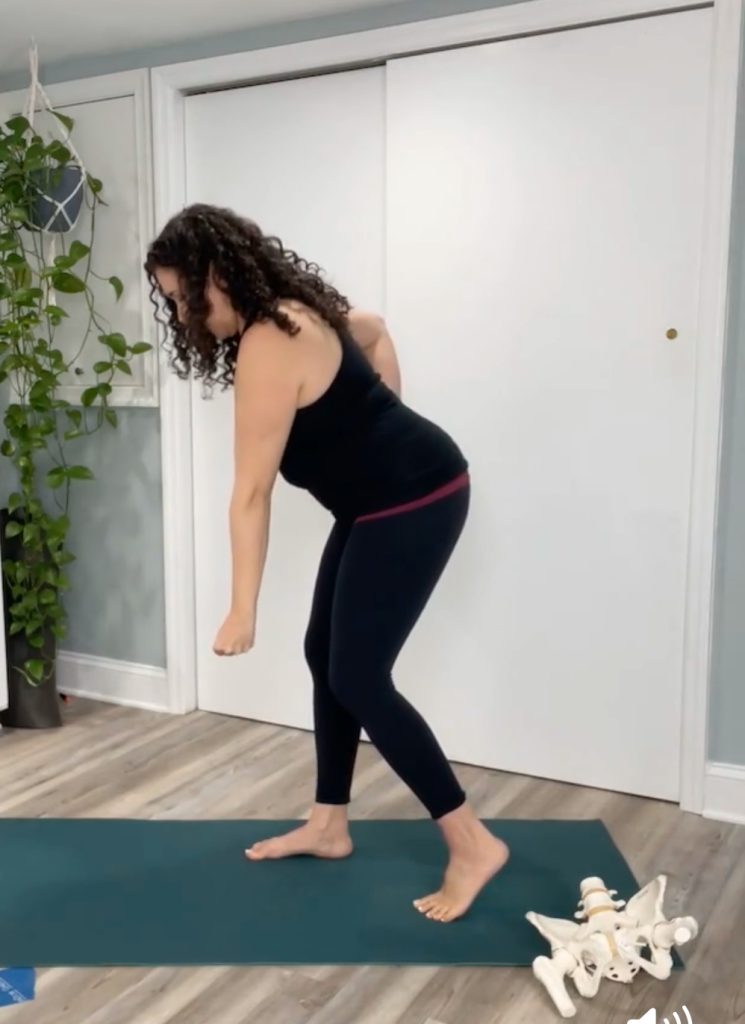
This foundational movement helps protect the lower back by encouraging mobility through the hips rather than the spine. RDLs strengthen the glutes and hamstrings, which are key components of the posterior chain and critical for pelvic support and postural alignment. Especially during pregnancy, when weight distribution shifts, developing strong hip hinging mechanics helps keep the spine neutral and reduce strain on the back and pelvis.
How to do it:
- Stand with feet hip-width apart, knees soft
- Place hands on hips or behind your head
- Hinge at the hips, sending sit bones back
- Keep spine neutral and chest lifted
- Press through heels to return to standing, engaging glutes
- You can also do it with a “kickstand” stance to make the front leg work even more!
Donkey Kicks
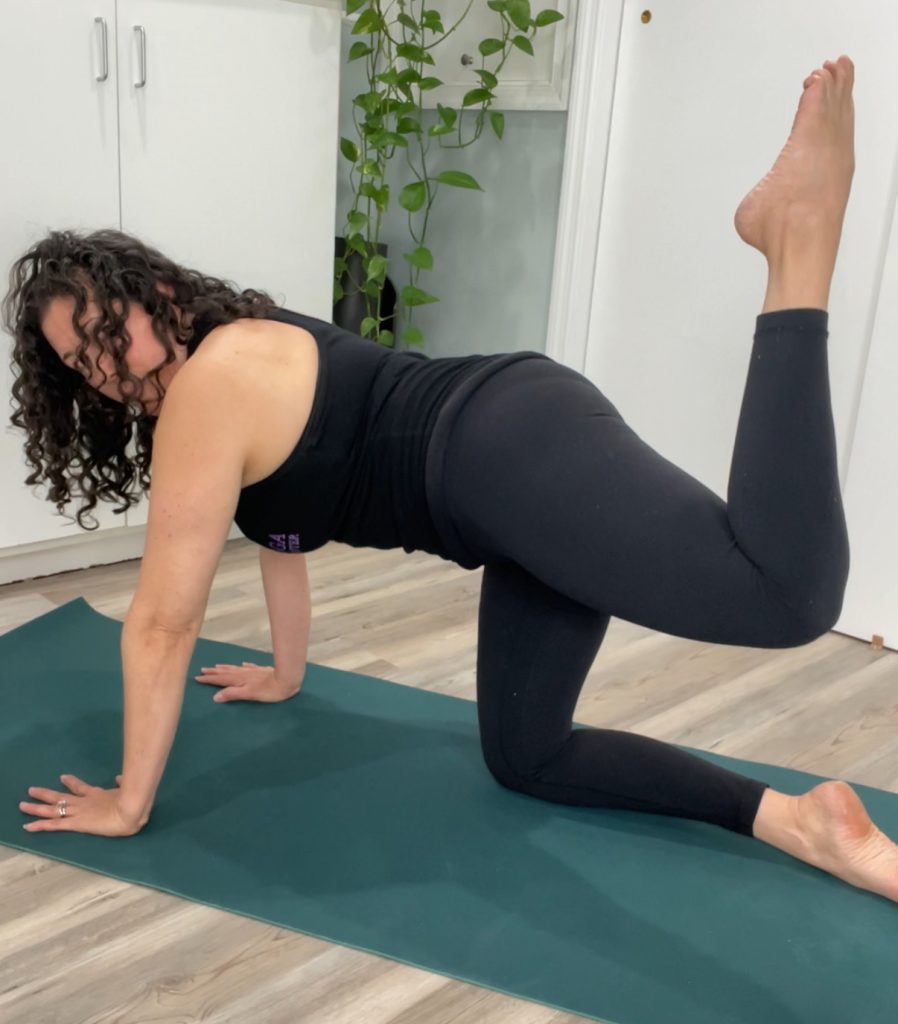
Donkey kicks are a simple yet powerful way to target the gluteus maximus, support hip extension, and stabilize the pelvis. Strengthening this area helps reduce sacroiliac joint discomfort and supports core control. It’s especially helpful in countering the forward shift in posture that can occur in pregnancy, keeping the hips balanced and the lower back supported.
Here’s how to do it!
- Begin in tabletop, spine neutral
- Bend one knee 90°, lift heel toward ceiling
- Avoid overarching your back
- Lower with control; repeat 10–15 reps per side
- Modify with blocks under forearms or sub with bridge if needed
*Modify by putting blocks under forearms for students with wrist issues.
*For students with SI (sacroiliac) or pubic pain, skip this one and do bridge with a block instead.
Bridge with Block
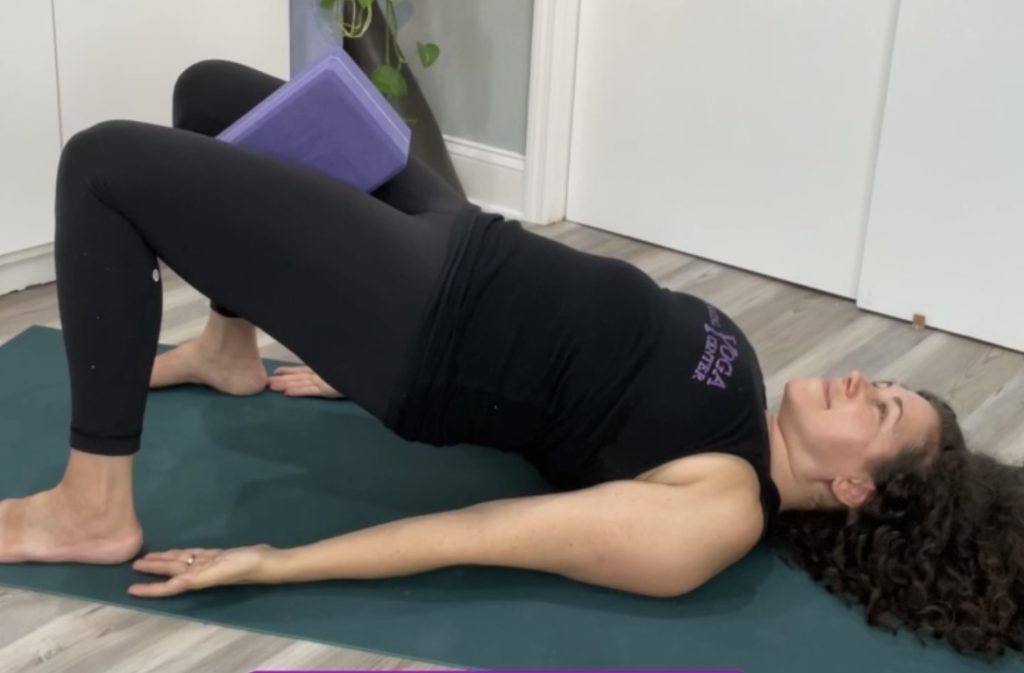
Bridge pose works multiple muscle groups at once, making it a great all-in-one strengthening exercise. It tones the glutes and hamstrings, and when a block is added between the thighs, it also activates the adductors (inner thighs). This pose helps maintain a lengthened spine and controlled pelvis—key for supporting both the low back and pelvic floor during pregnancy.
Here’s how to do it.
- Lie on your back, knees bent, feet flat
- Place a block between your thighs
- Squeeze block and lift hips focusing on lengthening the lower back and taking your tailbone towards your knee pits.
- Lower with control and repeat
Reverse Clamshell
Reverse clamshells are especially important for pregnant and postpartum bodies because they encourage internal rotation of the thigh bones. This movement helps widen the sit bones and lengthen the pelvic floor. At the same time, reverse clams target the often-neglected gluteus medius and minimus, improving lateral hip strength and contributing to pelvic balance, supporting a more functional birth and minimizing tension in the pelvic floor.

Here’s how to do it!
- Lie on your side, knees bent and stacked
- Place a block or towel between knees
- Lift and lower top ankle while keeping knees pressing in
- Stack hips and shoulders; elongate spine
- Add a resistance band for more challenge
Scapula Push-Ups
Scapula push-ups are a gentle yet effective way to strengthen the upper back and improve posture—both essential for balancing the changes of pregnancy and the physical demands of early parenthood (hello, baby-wearing and feeding!). This movement builds the serratus anterior, a key muscle for shoulder stability, which can reduce strain in the neck and shoulders, support spinal health and reduce headaches.
Here’s how to do it!
- In tabletop, maintain straight arms
- Press your hands into the floor
- Inhale and draw your shoulder blades together
- Exhale widen your shoulder blades apart
- Keep head and spine still, isolating upper back movement. This is not cat/cow
Opposite Limb Extension (Bird Dog)
This movement strengthens deep core muscles, spinal stabilizers, and the posterior chain, improving overall coordination and pelvic-lumbar stability. Bird Dog promotes balance and alignment, which helps prevent low back pain, supports daily movement, and enhances core integrity—especially important during pregnancy and postpartum when the body is working harder to maintain equilibrium.

Here’s how to do it!
- Start in tabletop, spine long
- Extend one leg back and opposite arm forward
- Keep hips square, core engaged
- Hold, then return to center and switch sides
- Modify by touching toes/fingertips to floor or doing one limb at a time
If you have SI or pubic pain, keep the back leg down and imagine pressing it upward. This will create an isometric contraction of the hamstring and glute and you will still get the benefit for the pose without causing pelvic pain.
Half Chaturanga with Transverse Abdominal (TA)Breathing
This move combines breath and strength training to safely engage the transverse abdominis (deep core). It builds upper body strength, supports spinal alignment, and teaches how to exhale with control, an important tool for labor and postpartum healing. Practicing chaturanga with focused breathing also helps students learn how to manage intra-abdominal pressure and stabilize the trunk without overstraining.

Here’s how to do it!
- From modified plank with a block between the thighs.
- Exhale like blowing out candles while bending your elbows, hugging them into ribs
- Keep spine long, avoid over arching your back.
- Draw your tailbone slightly downward toward the block with will help to gently engage your core
- Press back to start without collapsing shoulders
- Try at the wall for more support or if you are doming or baring down on your pelvic floor.
Final Thoughts: Why Strengthening Matters in Prenatal Yoga
At PYC, we believe prenatal yoga should do more than just help students stretch and relax—it should prepare them physically, mentally, and emotionally for the birth and parenting journey. Strengthening the body—especially the posterior chain and deep core—creates better alignment, reduces discomfort, and empowers our students with the tools they need to feel resilient and supported.
By integrating these kinds of poses into your prenatal practice, you’re not only building strength—you’re building confidence, body awareness, and long-term well-being.
To learn more about the Prenatal Yoga Center and the classes that we offer. Click below to view our class schedule.
Related Reading & Listening
Podcast: Strength Training for Pregnancy, Birth and Beyond with Nicole Scheitlin
Podcast: Birth Flow and Balance with Gail Tully of Spinning Babies®
What’s the Difference Between a Prenatal Yoga Class and a Yoga Class Modified for Pregnancy?

